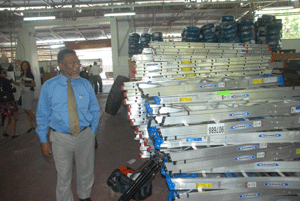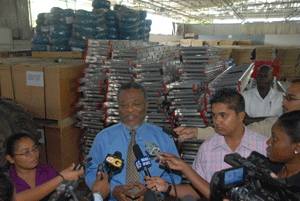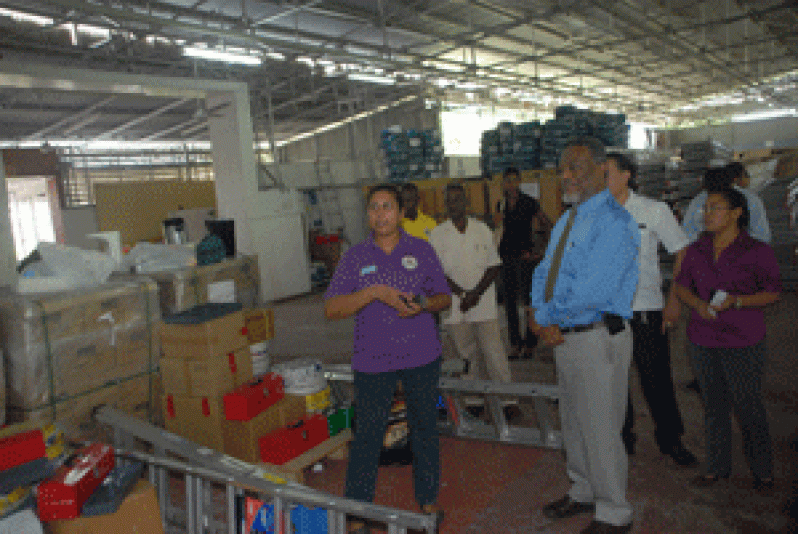1,888 solar systems delivered for hinterland electrification
GOVERNMENT continues to execute its Hinterland Electrification Programme (HEP) with the distribution of 11,000 solar home systems earmarked for the communities.  The undertaking, which targets the same number of households in about 184 Amerindian communities, is being executed by the Project Management Office, Office of the President, acting as Coordinator, with the Office of the Prime Minister responsible for procurement and monitoring activities, being supported by the Ministry of Amerindian Affairs.
The undertaking, which targets the same number of households in about 184 Amerindian communities, is being executed by the Project Management Office, Office of the President, acting as Coordinator, with the Office of the Prime Minister responsible for procurement and monitoring activities, being supported by the Ministry of Amerindian Affairs.
To date, 1,888 of the systems have been distributed, 1,000 of them last year November and, over last weekend, 888 were sent to Region 9 (Upper Takutu/Upper Essequibo).
Prime Minister Samuel Hinds, yesterday, visited the storage facility in the compound of the National Exhibition Centre, Sophia, Georgetown, where about 500, bound for Fly Hill, Kaicumbay, Quatata, Parashara, Nappi, Quarrie, Moco Moco and Semoni, villages surrounding the Lethem area in Region 9 were loaded onto trucks expected to leave, most likely, this evening.
Speaking to the media, he said government has been working to ensure that every family in Guyana has some amount of electricity.
“We have this programme for the hinterland areas. They are taking account of the technologies available and the cost – it’s attractive at this time to supply each home in the hinterland far away from any grid, a 65 watts photovoltaic solar home system,” Mr. Hinds said.
Each package to be delivered includes a complete set, including the photovoltaic panel, a battery, lights and wiring, he said, explaining: “They would be able to obtain about 12 to 15 kilowatt hours of electricity, which would be enough to supply lighting, in the first instance a number of lamps, and in this system we are supplying the low energy lamps.”
PRIMARY INSTALLERS He recalled that, sometime last year September, two persons from each village were trained and they will be the primary installers and each of them is expected to have two assistants.
He recalled that, sometime last year September, two persons from each village were trained and they will be the primary installers and each of them is expected to have two assistants.
Over a two months period in 2011, 390 persons from 184 villages in hinterland communities were trained in the assembly, installation and maintenance of the systems and each village council was, since, given responsibility for the management and maintenance of them, and residents in each village will pay a monthly contribution of $500 to a fund managed by the village council for services.
Trainers will be going into each village to certify that the systems have been installed correctly.
Prime Minister Hinds said, additionally, the Hinterland Electrification Unit is planning to visit each village twice a year to ensure that the systems are working properly.
Acknowledging that there were some delays in the delivery, he said: “This is our second wave of trucks going out to the Rupununi. For some areas in the Upper Mazaruni and in the higher part of Region 8 (Potaro/Siparuni), the only reasonable access now is by flying. So it works out to be a significant cost taking out this.”
“Our Hinterland Programme is not an Amerindian programme as such, it is a Guyanese programme but it happens that, maybe 95 percent of the people who live in remote areas are Amerindians,” he pointed out, adding that, as such, they have been working very closely with the Amerindian Affairs Ministry.
“We needed a place to store and, thankfully, the Ministry of Tourism, Industry and Commerce did make this place available,” Hinds admitted.
Projects Coordinator, Ministry of Amerindian Affairs, Ms. Sharon Austin said: “On behalf of the Ministry of Amerindian Affairs, we are pleased to have collaborated with the Office of the Prime Minister in this solar distribution programme.”
She said her ministry has assisted in putting together logistics and coming up with distribution costs and such, pointing out that the Hinterland Electrification Programme is just one of the investments government has made towards the development of Amerindians.
“We are expecting that, with this investment, the hinterland students would be able to use the energy and the lighting facilities to study and advance on their education pursuits and we look forward to completion of the project and the development of Amerindian communities as well,” Austin said.
This intervention is a key priority identified within the Low Carbon Development Strategy, and is the second stage of the Hinterland Electrification Programme (HEP).
The HEP was launched in 2005 when the Government of Guyana sought to explore options for the sustainable electrification of the hinterland, as part of the national Unserved Areas Electrification Programme (UAEP).
Pilot testing took place after the HEP launch and 65W Photo-Voltaic (PV) (solar) Home Systems emerged as the most feasible option for electrification for households.



.jpg)








